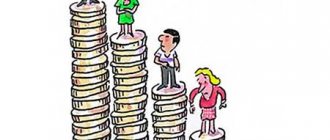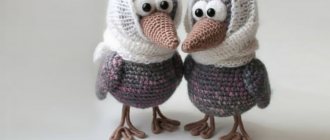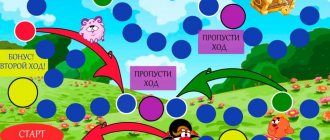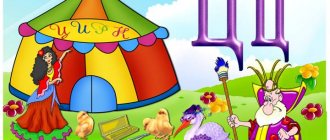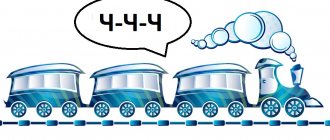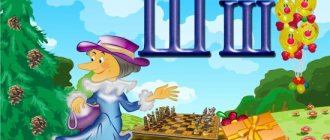Presentation: “Automation of the sound “R” at the beginning of words” - a multimedia guide to automating the sound “R”.
The sound “R” is normally formed in children by the age of 4.5 - 5 years. The reasons for the absence or distorted pronunciation of the “R” sound are different. But if your child does not have this sound in his speech by the age of five, then you should think about it.
Performing special exercises (articulation gymnastics) can help you pronounce this sound correctly. If this does not correct the situation, then we recommend that you seek help from a specialist.
Next, we proceed to automate the delivered sound in syllables, words, phrases, sentences, and coherent speech. All this material can be found at this link.
Since the automation process usually takes a long time, a huge amount of material is required. All this is so that the child’s interest does not fade away and he does not refuse to study.
It is for these purposes that a PRESENTATION FOR AUTOMATING THE SOUND “R” AT THE BEGINNING OF WORDS has been developed.
Benefits of presentations:
- All children love to play on computers and all kinds of gadgets. Therefore, this type of gaming activity will definitely interest them.
- All material and pictures are understandable for children.
- In the presentation, the child will be able to switch files himself, and this is an additional game moment.
- The presentation is a very accessible educational material that does not require any costs. All you need is a computer, laptop or tablet.
Also in this game guide are presented articulation exercises for the sounds “P”, “Рь”. They must be carried out before the start of the lesson in order to prepare the child’s speech apparatus to pronounce the sound “L” correctly.
You will find more complete information on performing articulatory gymnastics at the dedicated link.
Presentation: “Automation of the sound “R” in words” has been developed in several versions and is divided into parts. This is done so as not to tire the child with a long lesson. And most importantly, the basic rule is observed - automation of the sound “R” occurs in stages.
It is for these purposes that we have developed a presentation in 5 versions:
- Automation of the “R” sound at the beginning of words
- Automating the "R" sound in the middle of words
- Automation of the "R" sound at the end of words"
- Automation of the sound “R” in a combination of TR, DR
- Full version of the presentation (contains all three stages of automating the “P” sound)
There is only one presentation on our website: “Automation of the R sound at the beginning of words.” This version contains 21 pages on automating the “R” sound at the beginning of words.
We also have presentations on automating the “R” sound in the middle of words, on automating the “R” sound at the end of words, on automating the “R” sound in a combination of TR, DR, the full version of the presentation. They contain 20, 15, 18 and 74 pages respectively.
You can receive these presentations by emailing
You can also write feedback via email. You can find it at the end of each page.
In addition, in the presentation on the automation of the sound “R” you will be able to play educational games and exercises with your baby.
Presentation for the speech therapy lesson “Sound [r] in the circus”
- February 4, 2016
Competition "Master of Multimedia Technologies - 2015"
Nomination "Multimedia technologies in the pedagogical process in preschool educational institutions"
I present a summary of a subgroup speech therapy lesson on the formation of correct pronunciation with children of the preparatory group using a multimedia presentation.
Articulatory gymnastics in animated pictures attracts the attention of children and increases the effectiveness of correctional work. The visual and entertaining nature of the games allows, in the process of sound correction, to develop the skills of phonemic analysis and synthesis, and to strengthen the psychological basis of speech (attention, memory, perception, thinking). The presented material may be useful to speech therapists and parents of children with speech disorders.
Topic: “The sound [r] in the circus”
Goal: creating a social situation for the development of children in the process of automating the sound [r] in words and sentences.
Tasks:
I. _ Educational objectives:
1. Strengthen the skills of correct pronunciation of the sound [r] in words and in sentences.
2. Strengthen the skill of correct speech breathing.
3. Strengthen the skill of forming and using the plural of nouns.
II . Developmental tasks:
1. Develop articulatory motor skills.
2. Develop visual and auditory perception, attention, imagination, thinking.
3. Enrich your vocabulary.
4. Develop articulatory motor skills.
5. Develop fine motor skills of the fingers.
III . Educational tasks:
1. Cultivate strong-willed qualities and self-confidence.
2.Cultivate interest in speech therapy classes.
Vocabulary work: circus, juggler, fakir, acrobat, trainer.
Individual work: work on developing the correct pronunciation of the sound [r] in syllables, words and sentences.
Equipment: tables and chairs according to the number of children, multimedia installation, individual mirrors, presentation materials “Visiting the Circus”, 8 pink balls and 8 red balls, phonogram of V. Shainsky’s song “Circus”.
Progress of the lesson
I. _ Org. moment (The phonogram of V. Shainsky’s song “Circus” sounds).
- Children, where do you think we will go today?
We are opening the doors of the circus today. We invite all guests to the performance. In the circus today the music does not stop, the cheerful clown entertains everyone.
Demonstration of a slide on a computer (slide 2).
II . Breathing exercises “Let’s smell the flowers.”
Picture Ricky the Clown smelling flowers. Inhale through your nose, exhale and exclaim, “Oh, how it smells!” (slide 3).
III . Articulation gymnastics in animated pictures .
The circus is walking down the street, Everyone is standing with their mouths open!
Round your lips and convey the highest degree of surprise!
A circus performance will lift our spirits!
Keep your lips stretched in a smile for a long time (slide 4).
The clown in the circus makes everyone laugh: sometimes he’s happy, sometimes he’s sad
Lip massage: use your index fingers to lift the corners of your mouth up and down (slide 5).
Right, left, up and down, our lion jumps for an “encore!”
The mouth is open. The tip of the tongue reaches to the right corner of the mouth, then to the left, raise the tongue to the upper teeth and lower it behind the lower teeth (slide 6).
The bear is walking on a tightrope! He will receive honey as a reward,
Lick your upper lip with the wide tip of your tongue (slide 7).
They sat down on the swing together and flew up under the dome.,
Rhythmically raise the tongue by the upper teeth and lower the tip of the tongue by the lower teeth (slide 8).
And the acrobat athlete deftly rides a horse
The mouth is open. Lips in a smile. Click the tip of your tongue (slide 9).
IV . Isolated pronunciation of sounds [р], [р]. Characteristics of sounds [р], [р].
The serious games have arrived - the tigers enter the arena. Our tigers are not silent, but they growl with their cubs (slide 10).
- How a tiger roars - r-r-r.
- How a little tiger cub growls - roar-ry-ry.
– Tell us about the sound [r]. (Consonant, voiced, hard).
– How does it differ from the sound [r]. (The sound [r] is hard, and [r] is soft).
V. _ Exercise to develop the height and strength of the voice “Quiet - loud”.
– The tiger growls quietly, and then loudly: r - r - r - r (slide 11).
V. _ Development of phonemic hearing.
– Clap your hands if you hear the sound [r] in the words: rocket, circus, swing, bear, tiger, acrobat, clown, zebra.
– If the answer is correct, then a portrait of the sound [r] will appear on the slide (slide 12).
VI . Pronunciation of sounds [r] in syllables. Didactic game “Agree a word.”
Spectators came to the circus. Guess what their names are? (slide 13).
- And... (ra)
- Faith)
- Yura)
- Varya)
- Lera)
Choral game with the audience "Echo".
- Ra-ra-ra - it's time for all of us to go to the circus.
- Ru-ru-ru - a kangaroo is jumping in the circus.
- Ry-ry-ry - the guys have balls in their hands.
- Ru-ru-ru-the clown makes the kids laugh.
VII . Physical minute.
Children perform the “Clown” complex of logorhythmic gymnastics ( slide 14).
- Red-haired, freckled clown - they stroke themselves on the head, show freckles,
- The kids really like it - three claps,
- The nose is like a red tomato - stroke the nose alternately with your hands,
- And in his eyes there is enthusiasm - with the help of his hands they depict eyes and clap his eyelashes-fingers.
- Now he cries, now he laughs - his index fingers point vertically to his eyes, then to his lips.
- Either he is kind, or he fights - they stroke their hands, then throw their fists forward.
- Oh, how clumsy he is - his hands on his belt, his body tilting left and right.
- But this is how everyone needs him - arms crossed on the chest, to the sides and on the belt.
VIII . Pronunciation of sounds in words. Didactic game "Who's the odd one out?"
We won’t get bored at the circus; we answer questions:
- Who trains the animals? (Trainer).
- Who makes people laugh? (Clown).
- Who juggles the balls? (Juggler).
- Who performs tricks? (Fakir).
– Think about which one of them is the odd one out? (by the presence of the sound r) (slide 15) .
IX . Agreement of numerals with adjectives and nouns.
Ricky the Clown tried to learn how to juggle, but all his balls fell off (slide 16).
- Children, what should we do?
- How can we help the clown? (Children offer to collect balls)
– Let's count the balls: one red ball, two red balls, 3.., 4..., 5..., 6..., 7...8.
X. _ D/i "One-many".
“Now the fakir will turn one tiger into two at once.” Transform the animals so that there are many of them (slides 17, 18).
- Trained tiger – trained tigers
- Nimble monkey -...
- Fast horse -...
- An interesting trick is...
XI . Game "Wizard". Converting words.
– A magician at the circus turned his trunk into a robot. You and I will also become wizards. Replace the first sound in the word with the sound [r] (slide 19) .
- Trunk - robot
- Leg - …
- Lama -...
- Goats -...
- Flour - …
XII . Pronunciation of sounds [r] in syllables. Didactic game “Finish the sentences.”
– Rocky the Clown got everything mixed up. Correct his mistakes (slide 20).
A carriage flies across the sky. A rocket is traveling along the road. A crown is grazing in the meadow. The king has a golden crow.
XIII . Bottom line.
- Where have we been?
- What new have you learned?
- Who did we see in the circus arena?
- Who didn't we meet at the circus? Name them (slide 21).
- See you again with circus performers!
Bibliography:
1. Kosinova M.K. Speech therapist lessons. Games for speech development. M.: EKSMO, 2006.-173 p.
2. Lebedeva I.L. Difficult sound, you are our friend! Sounds R, R: A practical guide for speech therapists, educators, and parents. – M.: Ventana-Graf, 2004. -32 p.
3. Pozhilenko E.A. Methodological recommendations for creating the sounds s, sh, r, l in children. : A manual for speech therapists. St. Petersburg: KARo, 2006.-256 p.
4. Pozhilenko E.A. A magical world of sounds and words. – M.: VLADOS, 1999. – 224 p.
5. Pozhilenko E.A. The world around us: We teach to feel, know and act. A manual for speech therapists, educators, primary school teachers and parents: In 2 parts. Part 1. – St. Petersburg: “Prosveshchenie”, 2004. – 319 p.
6. Filicheva T.B. Elimination of general speech underdevelopment in preschool children. – M.: Iris-press, 2005. – 224 p.
7. Shashkina G.R. Speech therapy work with preschoolers: Textbook. – M.: Publishing House, 2003. – 240 p.
Author: Shishlyannikova Natalya Valerievna, speech therapist teacher, first qualification category, MBDOU "Kindergarten "Sanatorny", Abakan, Republic of Khakassia. 16 years of teaching experience, laureate of the competition “Project activity in an educational institution 2015”
These are games and exercises:
- “Name and repeat”;
- "Big small";
- “One is many”;
- "The fourth wheel";
- “Let’s do the math.”
These games will help not only automate the sound “R” in words, but also develop the grammatical structure of speech. Children very often make mistakes in the formation of nouns with diminutive suffixes, errors in the formation of plural nouns, in the agreement of nouns with numerals, etc.
These presentations will help you cope with this problem, and will also develop attention, thinking and memory.
Presentation: “Automation of the sound “R” at the beginning of words and all its versions can be received by the above mail.
We hope that our presentations will become your good assistants. And automating the sound “R” will not be a boring task, but an exciting game.
List of stories for automating the sound “R”
- "At a construction site"
- "In the garden"
- "In zoo"
- "We fed the birds"
- "Friend"
- "Yura and Raya"
- "Hole in the Pocket"
There is only one presentation on the site: “Automation of the sound R in the story “On a Construction Site.” This version contains 16 illustrated pages.
You can receive other presentations on automating the sound “R” in texts (6 stories) by writing to [email protected]
You can also write feedback via email. You can find it at the end of each page.
We hope that our presentations will become your good assistants. And automating the sound “R” will not be a boring task, but an exciting game.
Master class on the topic Methods of making the sound “R” - presentation
Master class on the topic: Methods of making the sound “R”
Objectives: 1. Develop the articulatory apparatus: Strengthen the muscles of the tongue and develop its mobility Stretch the hypoglossal ligament Work on the vibration of the tongue 2. Work on making the sound “R”
The timing of the final acquisition by children of vowels and consonants age sounds 1-2 A O E P B M 2-3 I Y Y U X F V T D N K G H Y 3-4 S Z Ts 4-5 SH ZH CH 5- 6 L R
Replacements of the sound “R” with “Y”, “L”, “L” are considered physiological up to 6 years. After 6 years they are pathological. Substitutions of “P” with “V”, “N”, “G”, “Y”, “E”, “U” are always considered pathological.
Causes of violations of the pronunciation of the sound “P” 1) Anatomical defects of the articulatory apparatus: short hypoglossal ligament, narrow and high (“Gothic”) palate 2) Paratic condition of the muscles of the tongue (tip and lateral edges of the tongue)
Correct articulation of the sound “R” The lips are open or their position is determined by the next vowel. Some distance is maintained between the upper and lower incisors. The tongue takes the shape of a spoon, its side edges are adjacent to the upper molars, and the front edge is raised to the alveoli, comes into contact with them and vibrates under the pressure of exhaled air.
Types of preparatory exercises 1. Exercises, 1. Exercises aimed at developing the correct position of the tongue. 2. Exercises, 2. Exercises aimed at developing vibrations of the tongue.
Exercises for lips: 1. “Smile.” 2. “Tube”. 3. “Smile - Tube.”
Exercises for the tongue: Punish a naughty tongue Open your mouth slightly, calmly place your tongue on your lower lip and, spanking it with your lips, pronounce the sounds five-five-five... Keep your wide tongue in a calm position with your mouth open, counting from one to five ten. “Pancake” (“Shovel”) Smile, open your mouth slightly, place the wide front edge of your tongue on your lower lip. Hold it in this position for a count of one to five ten. Whose teeth are cleaner? Open your mouth slightly and use the tip of your tongue to “brush” the inside of your upper teeth, moving your tongue from side to side.
Delicious jam Open your mouth slightly and lick your upper lip with the wide front edge of your tongue, moving your tongue from top to bottom, but not from side to side. Painter Smile, open your mouth and “stroke” the hard palate with the tip of your tongue, moving your tongue back and forth.
o “Fungus” Open your mouth wide, press the wide flat of your tongue against the roof of your mouth and suck on it. Hold your tongue in this position for 5-10 seconds. o “Swing” Smile, show your teeth, open your mouth slightly, put your wide tongue on your lower teeth (from the inside) and hold in this position for a count of one to five. Then lift your wide tongue by the upper teeth (also from the inside) and hold it for a count of one to five. So, alternately change the position of the tongue 4-6 times.
“Horse” Smile, open your mouth. Click the tip of your tongue like a horse clicking. The mouth is open, the tongue should be wide. Make sure that the tip of the tongue does not turn inward and that the lower jaw remains motionless. “Drum” (“Machine Gun”) Open your mouth, smile slightly and with the tense tip of your tongue tap on the alveoli (tubercles behind the upper incisors), repeatedly and clearly, in one breath, pronouncing the sounds “D-D-D”. Tap slowly at first and then increase the tempo. “Focus” (“Blow off the cotton wool”) Smile, open your mouth slightly, place the wide front edge of the tongue on the upper lip so that its side edges are pressed and there is a groove in the middle of the tongue, and blow off the cotton wool placed on the tip of the nose. The air should go in the middle of the tongue, then the fleece will fly up.
Exercises to stretch the hyoid ligament Hyoid frenulum The hyoid frenulum is a membrane that is located under the tongue and connects the tongue to the sublingual space. Short hyoid ligament (frenulum) Short hyoid ligament (frenulum) is a congenital defect consisting of shortening of the frenulum of the tongue (hyoid ligament). For the little ones, we can recommend the following exercises: “Lick the saucer.” Invite your child to lick the saucer like a kitten. You can reach with your tongue for a spoon. “Reach your tongue to your chin.” “Reach your tongue to your nose.”
“Swing” “Delicious jam” “Painter” “Lapping” “Mushroom” “Accordion” Suck the wide tip of your tongue to the palate, as in the “Mushroom” exercise, and then, without peeling off your tongue, open and close your mouth. "Drum"
Ways to make the sound “R”: 1. By imitation: a. Tongue in the “Mushroom” position, forcefully exhale “TRRR” (or “DRRR”); b. Try to exhale “C”; c. When performing the “Machine Gun” exercise, hit with the edge of your palm under the chin.
2. Mechanical method (“balalaika”): a. Perform the “Machine Gun” exercise using a probe (spatula) or finger, making quick horizontal movements along the tip of the tongue. b. With the help of “Balalaika” the sound “R” can be obtained from “F” or “Z” (top row). 3. Using your first index fingers, press the lateral edges of the tongue to the palate, leaving the middle of the tongue free. Taking a deep breath, blow out the air while turning on your voice.
Automation of sound in speech: 1. In syllables. 2. In words. 3. In phrases. 4. In sentences, poems, nursery rhymes, pure sayings. 5. In the text.
Reflection “Telegram” Write a short message-telegram, answering the questions: 1. What do you think about the last lesson? 2. What was important to you? 3. What did you learn? 4. What did you like? 5. What remains unclear? 6. In what direction should we move forward?
Presentation "Makar and Artyom". Automation of the sound [P] in reverse syllables
Slide 2. Formation of relative adjectives: potato, tomato, carrot. You can invite the child to repeat/make sentences with these words. For example, Makar loves/sees/eats carrot salad. The transition to the next slide is carried out either by clicking, or by clicking on a button with a sound effect.
Slide 3. Formation of relative adjectives: watermelon, blueberry, peach. You can invite the child to repeat/make sentences with these words. For example, Artyom loves/sees/drinks blueberry juice.
Slide 4. Formation of the relative adjective cardboard. You can invite the child to repeat/make sentences with these words. For example, Makar glues a basket out of cardboard. Makar glues a cardboard basket. Questions and pictures by clicking.
Slide 5. Formation of the relative adjective sport. You can invite the child to repeat/make sentences with these words. For example, Makar and Artyom put on sportswear and go to the gym. Questions and pictures by clicking.
Slide 6. Use of the word first.
Order the original presentation: This e-mail address is being protected from spambots. You need JavaScript enabled to view it.
All presentations here
Slide 7. Formation of the relative adjective brick. You can invite the child to repeat/make sentences with these words. For example, Makar and Artyom live in a brick house. Questions and pictures by clicking.
Slide 8. Formation of the relative adjective northern. You can invite the child to repeat/make sentences with these words. For example, The north wind is blowing. Questions and pictures by clicking.
Slide 9. Formation of the relative adjective wool. You can invite the child to repeat/make sentences with these words. For example, Artyom put on woolen signets. Questions and pictures by clicking.
Slide 10. Come up with suggestions based on the pictures. For example, Makar puts on a jacket and a woolen scarf. Pictures on click.
Slide 11. Come up with suggestions based on the pictures. For example, Makar and Artyom go to the yard and then to the zoo. Pictures on click.
Slide 12. Name the animals: badger, raccoon, monkey, hippopotamus, camel, walrus, lion, leopard, panda. Select words with the sound R and click on the picture. If you click incorrectly, there will be a sound signal.
Slide 13. Choose the appropriate word according to its meaning. A child or adult reads the verb, then you need to select the appropriate picture (noun) and click on it. State the entire sentence. Change words by click. Pictures: samovar, fly agaric, cucumbers, kefir, sugar. Click on the fly agaric - a sound signal.
Slide 14. The task is the same. Pictures: carpet, apron, fan, ruff, window. Click on the fan - a sound signal.
Slide 15 – 16. Answer the question in a complete sentence. Question and pictures by clicking. Pictures: envelope – stamp; shorts – slide pocket – yard; bonfire - park
Slide 17. Answer the question in a complete sentence. Question and pictures by clicking. Pictures: Makar - cheese - Artyom cakes - food - feeder
Slide 18 – 19. Listen to the fable sentence, correct it, say it correctly. If you click on the background, the pictures will swap places, and then a new offer will appear. Click again - the pictures change places.
Sweet 20. Surprise moment - circus.
Author of the material GBOU secondary school 863 SPDO 2, speech therapist teacher: Lidiya Vadimovna Vlasova
Also on topic:
Presentation Automation [p] in the syllable “tra”
